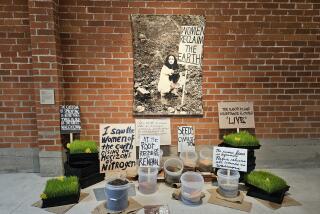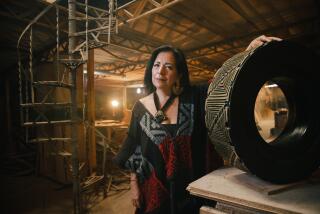Uncommon Folk
- Share via
fisherman casts his line and fantasizes about dancing mermaids. Villagers climb a mountain only to tumble down when it erupts. A man and woman put on bathing suits for a day at the beach--in hell.
The colorful images appear on paintings, wooden sculptures, boxes and other pieces at the Timbuktu Folk and Tribal Art gallery in Costa Mesa. They’re the work of Mujeres En Marcha (Women in Action), a Costa Rican women’s art collective that started when a mother dreamed of ways to help her family.
It was 1992 and John Breuer was working on a low-income housing project for the Peace Corps in rural Costa Rica. A woman approached him, saying she had to make more money to take better care of her children. But there were few jobs in San Jose, Venecia or any of the other towns that a mother could do at home.
Then it came to him. Breuer knew of another woman living nearby who taught art reflecting the indigenous styles of the region. The mother went to her, learned how to paint and do other crafts, and eventually other women followed.
It wasn’t too long before Mujeres En Marcha was alive with Breuer’s help.
Now the pieces (which sell for $200 to $250 each) are sought by both collectors and those who see folk art as purely decorative. Breuer noted that the five group members make about $3,000 each a year, a healthy sum to them. It’s about the same as the women’s husbands earn annually as farmers, he said.
“This has definitely helped their lives [and] made what were hard lives a bit easier,” Breuer said. “But really, this project isn’t only about making money. It’s really about these women expressing themselves. If their expression touches something in somebody, it shouldn’t be only about that these are poor women, ‘Let’s be nice and give them some money,’ but has this led to an economic revival for them? Sure, it has.”
It wasn’t easy for the women at first. Breuer said most of them had never dabbled in art, even casual drawing, before coming to the collective.
And learning basic technique wasn’t the only problem. Their lives were so traditional that the notion of painting a nude left them uncomfortable. It also made their neighbors nervous. Seven of the original 12 that began Mujeres En Marcha dropped out.
“These are conservative people; it was just strange for anyone to represent a naked figure,” Breuer said. “Some people saw them painting or drawing something like that and they weren’t sure, they thought it was a waste of time.”
That affected some of the first participants.
“Slowly, but surely, I think, the women opened their eyes. Other people did too and saw the value of what they were doing.”
Breuer, who lives in San Francisco and plans to take the group’s work to other Southern California galleries and on a tour of Costa Rica, says the art should be taken seriously.
He realizes that folk art, whether from Mexico or South America, is often perceived as mere home decoration, an attitude he vigorously rejects.
“I guess these can end up that way, but it depends on your interpretation of folk art,” Breuer said. “Most of the people who buy these don’t buy them to match their drapes. Most are serious collectors [and] that’s appropriate.”
The pieces clearly embrace folk art traditions, meaning they’re bold, primitive and highly fanciful. It’s also apparent the artists attended the same school. Though the themes vary, the techniques and styles are similar; it’s as if they all could have been made by the same artist.
Regardless, the dreamy subject matter draws you in.
That’s how Marge Lipscomb felt. The 48-year-old Irvine resident said she’s collected folk art, mainly from Mexico, for several years and the Costa Rican objects fit in well with her others.
“What I like are interesting stories” the art can tell, she said. “Good folk art is a little surreal and very graphic. These are very picturesque images.”
Another gallery visitor, Jason Emory, appreciated the intentionally unsophisticated look of the works. They seemed personal to him.
“They’re not all perfect like some representational art [but] they have a sweetness about them,” explained Emory, 28, of Costa Mesa. “And they’re so bright, they just reach out and grab you.”
His wife, Karen, agreed. And once she learned something of the story behind Mujeres En Marcha, she was even more taken.
“It’s exciting to know that they found a way to express themselves and make their lives better,” she said. “You can feel inspired just looking at what they’ve done.”
Mujeres En Marcha’s “Through Our Eyes” exhibit continues at the Timbuktu Folk and Tribal Art gallery through Sept. 8. Timbuktu is at 1661 Superior Ave., Costa Mesa. (714) 650-7473.
More to Read
The biggest entertainment stories
Get our big stories about Hollywood, film, television, music, arts, culture and more right in your inbox as soon as they publish.
You may occasionally receive promotional content from the Los Angeles Times.










